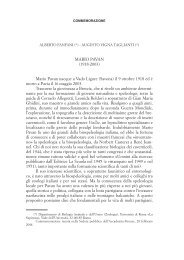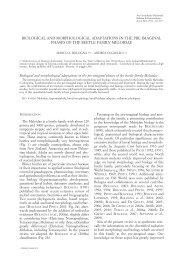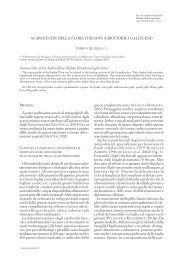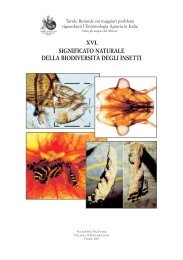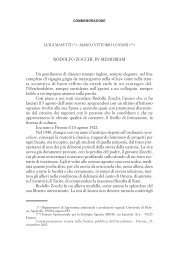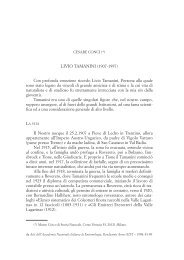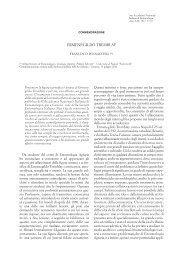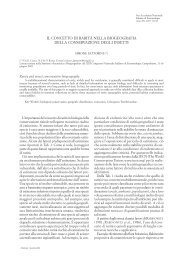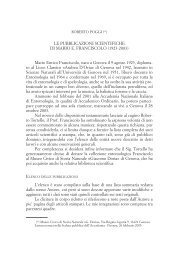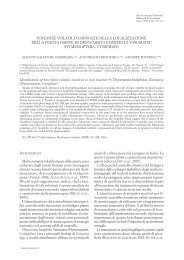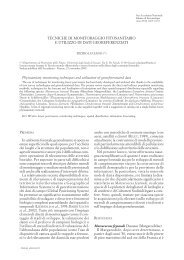XXII CNIE - Accademia nazionale italiana di Entomologia
XXII CNIE - Accademia nazionale italiana di Entomologia
XXII CNIE - Accademia nazionale italiana di Entomologia
Create successful ePaper yourself
Turn your PDF publications into a flip-book with our unique Google optimized e-Paper software.
Modelling pre<strong>di</strong>cts that invasive species which have a high mobility, although they could<br />
more easily follow the migration of the climate envelope, may fail to expand when they<br />
face both a local narrowing of the envelope boundary, such as the one generated by<br />
Alpine corridors, and an Allee effect (Roques et al. 2008). At present, most (78%) exotic<br />
insect species already present in Europe are restricted to one or two countries, less than<br />
1% (mostly seed beetles and insects of stored products) having colonized all of the<br />
European countries (Roques et al., 2009).<br />
Mechanisms underlying invasion success in the context of climate change<br />
All these aforementioned examples suggest that changing climatic con<strong>di</strong>tions, and<br />
warming in particular, appear to have an increasingly important role in triggering<br />
increases in population abundance and <strong>di</strong>stribution not only of native but also of alien<br />
species in the period with altered climatic con<strong>di</strong>tions since the 1970s. In many cases, an<br />
in-depth understan<strong>di</strong>ng of the ecological limits of the species and how these have<br />
changed during the recent past supports this hypothesis. Such changes are particularly<br />
obvious at higher latitudes and altitudes, where previously there were thermal<br />
constraints. A remarkable example is the pine processionnary moth, Thaumetopoea<br />
pityocampa (Lepidoptera: Notodontidae), an originally Me<strong>di</strong>terranean insect which is<br />
currently expan<strong>di</strong>ng its range <strong>di</strong>stribution towards higher latitudes and altitudes (Battisti<br />
et al., 2005). Larval development occurs during winter and is limited by both lethal<br />
temperatures (-16°C) and temperatures allowing fee<strong>di</strong>ng (i.e. night air temperature below<br />
0°C and temperature inside the nest below 9°C on the prece<strong>di</strong>ng day; Battisti et al.,<br />
2005). Climatic models based on these thresholds revealed an unfavourable area in the<br />
South of the Paris Basin (France), which constrained the insect <strong>di</strong>stribution up to the<br />
1990s. Along with warming up since 2000, the moth is no longer limited by unfavorable<br />
larval fee<strong>di</strong>ng con<strong>di</strong>tions and succeeded in crossing this area and expan<strong>di</strong>ng its range<br />
<strong>di</strong>stribution by around 5.6 km per year (Robinet et al., 2007).<br />
The same model also showed that warming up may have contra<strong>di</strong>ctory effects depen<strong>di</strong>ng<br />
on time (winter vs. summer) and location in relation to the timing of insect development.<br />
Whereas the warm winter 2003 triggered larvae survival in newly colonized areas of the<br />
Paris Basin, the heat wave of summer 2003 killed a large part of the population in the<br />
same area (Robinet et al., in press). Contra<strong>di</strong>ctorily, the high temperatures observed in<br />
summer 2003 resulted in a significant altitu<strong>di</strong>nal shift of the moth in the Italian Alps<br />
(Battisti et al., 2006). Indeed, the moths emerged earlier in the first case and egg-masses<br />
and first- instar larvae were exposed to extremely high temperatures whilst these<br />
temperatures occurred during adult flight in the Alps, and enabled a higher proportion of<br />
female moths to <strong>di</strong>sperse at unusually long <strong>di</strong>stances.<br />
These examples show that some alien species profit from ameliorated con<strong>di</strong>tions, mainly<br />
owing to warmer temperatures. Much less is known of introductions that failed or<br />
species that show range contractions as a consequence of climate change (Parmesan et<br />
al., 1999). Moreover, besides temperature, other aspects of climate change, such as<br />
changes in precipitation regimes, are also likely to influence invasion processes. There is<br />
observational evidence from long-term monitoring data gathered since 1993 suggesting<br />
that increase in rainfall promotes a wider <strong>di</strong>stribution of the introduced Argentine ant<br />
Linepithema humile into new areas in California (Heller et al., 2008). As in the case of<br />
climate change impacts on native species, the data on impacts of changing rainfall<br />
regimes on alien species is less rea<strong>di</strong>ly available than of temperature and it remains to be<br />
seen whether general, pre<strong>di</strong>ctable patterns will arise.<br />
The future?<br />
As mentioned above, more than 400 out of the 1315 non-native insect species<br />
established in Europe originated from areas with subtropical and/or tropical climate and<br />
15



